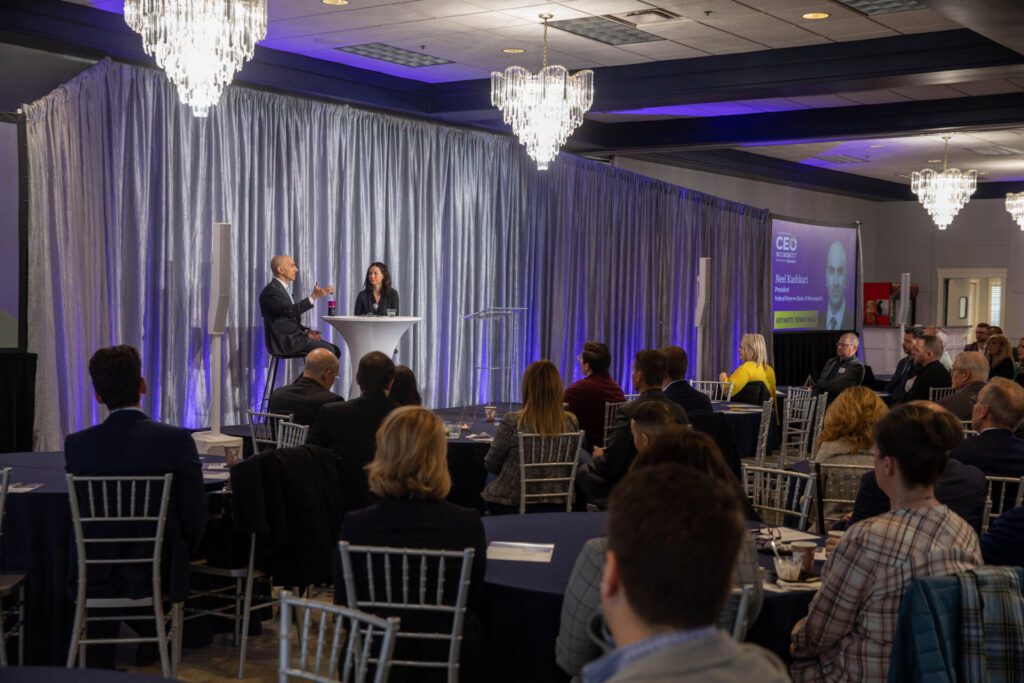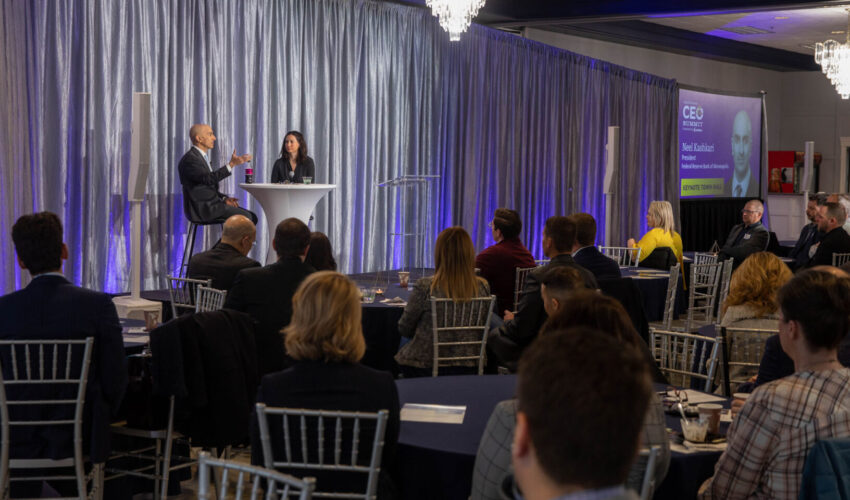Jodi’s Journal: The problems money can and can’t solve
March 12, 2023
It started with removing the state sales tax on food.
Then, it progressed to an across-the-board reduction in the state’s general sales tax rate.
Then, I started hearing about rebating property tax dollars back to homeowners.
And then, I heard from Neel Kashkari.
The president of the Federal Reserve Bank of Minneapolis spoke at our inaugural CEO Summit recently. While it was a timely talk on many levels, his comments on state budgets in our region rang especially relevant in the context of what was being discussed simultaneously in our state Capitol.
“State budgets, generally in our region, are very flush,” Kashkari said.
For instance, his home state of Minnesota has about a $50 billion state budget and a $17 billion “monster surplus,” he said.
Others states are in similar situations, he continued, looking routinely at 30 percent surpluses. In South Dakota, it’s over $400 million.
“On one hand, that’s great. State governments are doing well. Local governments are doing well,” he said.
“Some of those states are talking about rebating that money to taxpayers. As a taxpayer, that sounds pretty good to me. But as a monetary policymaker, that sounds like more stimulus.”
And that’s in large part how we ended up with this level of inflation — and related price increases — in the first place.
Remember the pandemic-related government checks? People spent them, the supply chain got gummed up, and suddenly prices surged up.
So now, as we’re all paying more, it’s tempting for elected officials to try to ease the pain.
But does it?
“If that’s putting more money in people’s pockets to go out and spend on airplane tickets and food and buying things, again it’s hard to say that’s bad, but it does feel like more stimulus,” Kashkari said. “And it gives me pause, saying maybe there’s more stimulus yet coming, even if it’s not coming from the federal government.”
I will not claim to be a close follower of the day-to-day drama that can ensue during the legislative session. But every time I began hearing talk about returning money to taxpayers, Kashkari’s words rang in my head.
Now, legislation is headed to the governor’s desk for final approval that would reduce the overall sales tax rate from 4.5 percent to 4.2 percent until 2027.
Honestly, other than trying to net some political points and undo a sort of bizarre approach to justifying taxing internet sales, I don’t understand the rationale.
Inflation-related pricing pressure is a problem money can’t solve. Conversely, it’s a problem excess money helped cause.
The hard truth is there is going to be some pain to endure while the Federal Reserve attempts to drive inflation down to its 2 percent target. Consumers will start pulling back on their spending. There will be job losses. Wages won’t increase as fast.
These things have to happen because the alternative actually is worse. And, as Kashkari noted, “Typically when the central bank has caused a recession by raising interest rates, the bounce back can be very fast.”
In South Dakota, as is generally the case, whatever economic downturn occurs likely won’t be as severe.
“The Sioux Falls economy is basically booming. There are, of course, challenges, but overall business is doing very well in this community,” Kashkari said.
In short, we don’t need a symbolic tax cut. We need smart spending — or saving — of our surplus to address today’s challenges and position us for tomorrow’s.
Ask almost any business leader in this community what the most pressing challenge is today and the answer likely will be the same as it was three years ago or 30 years ago: workforce.
While the nation is experiencing acute issues related to workforce — everything from people dying during the pandemic to people retiring early — in Sioux Falls, “you have a structural problem,” Kashkari told us. “The long-run structural issues monetary policy can’t do anything about.”
Another problem money can’t solve.
In advanced economies, Kashkari continued, people are having fewer children. That’s a problem for the workforce and a problem for the future base of consumers.
“The only real solution to this … the only answer is immigration. This is a structural issue we as a country have to get our heads around, sensible immigration policy that meets the needs of our economy.”
It’s not a political issue, he continued.
“It’s simply math.”
I have seen some promising examples of South Dakota businesses attempting both to use temporary work visas and to reach out to new Americans to support workforce needs. But there need to be many more of them, and I haven’t sensed much appetite for encouraging it in this state. We could, however, use public dollars to help offset the cost of training or upskilling workers in those in-demand occupations or emerging technologies.
One of the most interesting insights also came with the last question Kashkari answered at our summit — about the need to increase access to child care.
“This affects the labor market because it affects people’s ability to work, but it also affects our future workforce,” he said. “The more educated our young people are, the more productive our economy is going to be. This is where productivity comes from. It’s enormously important.”
Kashkari then compared child care funding challenges to agriculture, which nearly every country subsidizes.
“Governments want low prices for consumers and high prices for farmers. Those two things are in conflict, and the only way you can achieve both is with government subsidies,” he said.
“Now look at child care. If we want decent wages for child care workers and affordability for families, those two things are in conflict. And so ultimately as a country, we have to decide: Is this something we’re going to prioritize or not? There’s no way of squaring those two things without some form of government support. … That is a fundamental tension that there’s no other way of addressing.”
A study last year from the Sioux Falls Childcare Collaborative identified a more than $600 million gap in child care affordability. Whether that’s the “right” number I’m sure could be further analyzed, but Kashkari’s point is hard to dispute: Competitive wages for child care workers and families’ ability to pay them are in conflict. And “helping all of our citizens be able to participate in the economy” seems like a fitting role for government.
It’s a problem money could solve.
In the discussion over reducing the 4.5 percent sales tax to 4.2 percent, it was reported that 0.3 percent in statewide sales tax generates more than $100 million. Think about that, and maybe instead of cutting the rate, think about even a slight increase to it and how a public-private partnership could help fill that child care gap. Think about how South Dakota could pilot an approach using a combination of state, federal and private dollars to do just what Kashkari mentioned.
And maybe it does involve eliminating the sales tax on food. I understand that moral argument. But the broader reality is that in places with growing populations, sales tax generally is higher. When I go back to my hometown in Ohio, I don’t pay sales tax on food, but I do pay a general sales tax of 8 percent, of which 5.75 percent goes to the state. Population growth alone is not enough to fund the corresponding cost of growth to government. But, much like controlling inflation, the alternative — not growing — is worse.
It’s undoubtedly a complex environment to navigate. But as I listened to this appointed official tasked with monetary policy, I realized it might help if the elected officials in charge of fiscal policy thought a bit more about the problems money can and can’t solve.
Minneapolis Fed president talks inflation, economic conditions at SiouxFalls.Business CEO Summit








